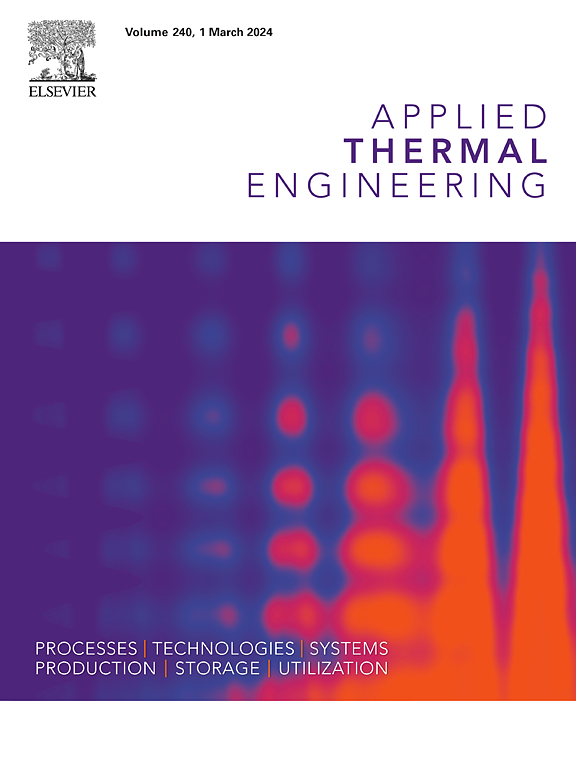回填体地热系统二级级联相变材料热力学性能的熵能协同优化
IF 6.9
2区 工程技术
Q2 ENERGY & FUELS
引用次数: 0
摘要
级联潜热蓄热技术是利用相变材料在特定温度下的潜热释放来提高地热蓄热系统稳定性和效率的一种有效策略。本研究开发了一种新型的回填体级联潜热储存地热利用(BCLHSGU)系统,采用三种不同熔点的石蜡作为充填体PCM。利用ANSYS Fluent软件对该系统的放热过程进行了仿真。首先,对单级和两级系统的传热性能进行了综合分析。接下来,通过调整进口温度和工作流体流量,测试了两级系统中每个相变单元在不同工况下的热力学性能。通过协同熵能分析和敏感性分析,进一步研究了两级系统的放热性能,重点量化了关键因素对放热过程的影响。最后,全面评估了附加相变阶段对整体放热性能的影响。结果表明,与单级系统相比,两级系统的放热时间减少了14.15%,并且沿路径的传热温差均匀性更好。通过降低进口温度,两级系统的散热效率和能量效率分别提高了9.51%和9.5%,而能量耗散增加了6.76%。相反,增大WF进口流量,其放热效率和能量效率分别显著提高31.59%和31.31%,能量耗散显著降低71.88%。此外,WF入口温度对能量和能量增益的敏感系数比WF入口速度高近两个数量级。与两级系统相比,三级系统在放热性能方面没有表现出任何重大改善。相反,它导致在后期放热期间增加系统耗散。本研究开发了一个新的熵能协同分析框架,有效地解决了BCLHSGU系统中热量提取效率和耗散之间的关键权衡。研究结果可为充填体潜热蓄能系统(BLHESS)的高效排热提供参考。本文章由计算机程序翻译,如有差异,请以英文原文为准。
Entransy-energy synergistic optimisation of thermodynamic performance in two-stage cascaded phase change materials for backfill body geothermal system
Cascaded latent heat storage technology has emerged as an effective strategy to enhance the stability and efficiency of geothermal storage systems by utilising latent heat release of phase change materials (PCMs) at specific temperatures. In this study, a novel backfill body cascaded latent heat storage geothermal utilisation (BCLHSGU) system was developed, using three paraffin wax types with distinct melting points as the backfill PCM. Heat release process of this system was simulated using ANSYS Fluent software. First, heat transfer performance along the paths of both single-stage and two-stage systems was comprehensively analysed. Next, thermodynamic performance of each phase change unit within the two-stage system was examined under varying operating conditions by adjusting inlet temperature and working fluid (WF) flow rate. Heat release performance of the two-stage system was further investigated through a synergistic entransy-energy analysis and sensitivity analysis, focusing on quantifying the influence of key factors on the heat release process. Finally, the impact of additional phase change stages on the overall heat release performance was thoroughly evaluated. Results revealed that the two-stage system exhibited a 14.15% reduction in heat release time compared to the single-stage system, with superior uniformity in heat transfer temperature differences along the path. By lowering WF inlet temperature, heat release efficiency and entransy efficiency of the two-stage system were enhanced by 9.51% and 9.5%, respectively, although entransy dissipation increased by 6.76%. Conversely, increasing the inlet flow rate of the WF led to significant improvements in heat release efficiency and entransy efficiency, by 31.59% and 31.31%, respectively, while dramatically reducing the entransy dissipation by 71.88%. Additionally, the sensitivity coefficient of WF inlet temperature to energy and entransy gains was nearly two orders of magnitude higher than WF inlet velocity. When compared to the two-stage system, the three-stage system did not show any major improvement in heat release performance. Instead, it led to increased system dissipation during the later heat release period. A novel entransy–energy synergistic analysis framework developed in this study effectively addresses the critical trade-off between heat extraction efficiency and dissipation within the BCLHSGU system. These findings provide a reference for the efficient heat extraction of the backfill body latent heat storage energy system (BLHESS).
求助全文
通过发布文献求助,成功后即可免费获取论文全文。
去求助
来源期刊

Applied Thermal Engineering
工程技术-工程:机械
CiteScore
11.30
自引率
15.60%
发文量
1474
审稿时长
57 days
期刊介绍:
Applied Thermal Engineering disseminates novel research related to the design, development and demonstration of components, devices, equipment, technologies and systems involving thermal processes for the production, storage, utilization and conservation of energy, with a focus on engineering application.
The journal publishes high-quality and high-impact Original Research Articles, Review Articles, Short Communications and Letters to the Editor on cutting-edge innovations in research, and recent advances or issues of interest to the thermal engineering community.
 求助内容:
求助内容: 应助结果提醒方式:
应助结果提醒方式:


